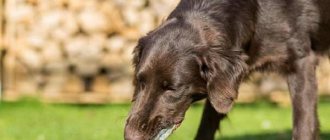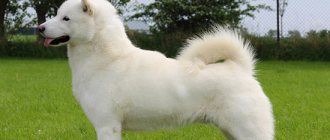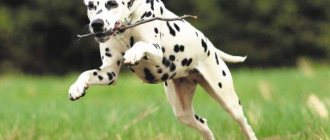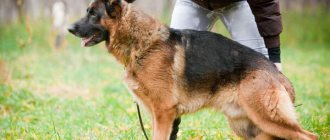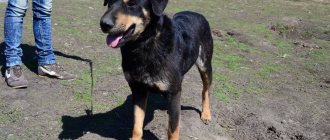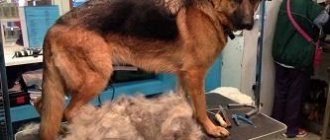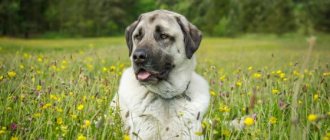The White German Shepherd is considered a rather rare breed, which was practically unknown in Europe for several decades, but is very famous in America.
Previously, such a dog was used as a shepherd, so it is still sometimes called a “herding dog” for its light color and friendly character.
In general, the albino shepherd is completely similar in appearance to its German ancestor, with only minor differences.
What details of the animal’s character are fundamentally different from the breed standard?
Origin story
During the Enlightenment of the 18th century, the German states were covered by a wave of crimes, so the question arose of creating a special service dog to help the police.
One cynological community, Philax, has set itself the goal of developing a new breed from local herding shepherd dogs from different regions of Germany (Thuringia, Bavaria, Württemberg and Saxony).
Constantly subject to criticism about what the next breed should become in the final version, the community itself did not last long.
However, it still managed to leave important developments on white shepherds:
- drew attention to the value of many qualities inherent in herding dogs;
- developed a certain view on the required type of police service dog.
Smart pets with a snow-white color quickly won the hearts of private dog breeders. Rumors about the new breed quickly spread beyond the country, and puppies began to be sold to the UK, and from there to Canada and America.
NOTE!
The descendants of the German Shepherd carry the white gene in a latent state, so each subsequent mating in 90% of cases out of 100 will necessarily produce one or more puppies of the required shade in the litter.
Left without strict control from professional dog handlers, amateur breeders made every effort to breed shepherd dogs that are in greatest demand - light-haired ones.
Today, the white color, which almost destroyed the breed in Germany as a glitch in genetics, has become one of the reasons for its popularity. Fans of non-standard species get white shepherds primarily because of their unusual appearance and character inherent in a real working dog.
Training and education
The Swiss Cattle Dog is extremely hardworking, disciplined and responsible. She has an excellent memory, she learns quickly, remembering commands almost the first time. The obedience of a shepherd is at the highest level, subject to proper upbringing and training.
The basics of training take place at an early age, up to 5-6 months, at which time the puppy masters basic commands. A six-month-old pet can already be trained at a more serious level. A young shepherd dog at the age of 1 year is ready to undergo a special training course.
It is recommended to master complex specialized skills (protection, assistance to people with disabilities, etc.) with the help of a specialist at a special training site.
Interesting Facts
- The first officially registered German Shepherd with a regular coat color had a great-grandfather with a pure white coat.
- The Swiss Cattle Dog was valued by farmers because it blended in with the white wool of the sheep, without standing out in the flock that was under its protection.
- For a long time, they did not want to recognize this breed as a separate species. All because of the erroneous belief that white coat color negatively affects the performance of dogs.
Marriage or breed?
The dogs, known since 1882, gained recognition among dog breeders only at the beginning of the 21st century.
In the Fédération Cynologique Internationale (FCI), the white German breed was admitted for registration only in 2002, under standard number 347, in Section I of the “Shepherd Dog”, as a herding and service dog. Although this albino has nothing to do with the real Swiss Shepherd - the Sennenhund (Schweizer Sennenhund) and all its types.
Initially, the white gene was recognized as a defect, and all representatives of this breed were mercilessly culled, which led to their almost complete disappearance. But this applied exclusively to kennel clubs that adhered to German standards.
But in the USA, by that time the dog had already established itself as an independent breed and received a new name - “American-Canadian White Shepherd”. From abroad they were reintroduced to Europe, where they received a chance for renewed popularity. And although the breed is officially recognized by the International Cynological Federation, due to the fact that the United States is not a member of it, the name of the breed was changed in accordance with the norms of the federation.
Expert opinion
Kozhevin Semyon Kirillovich
Expert dog handler.
As experts note, the white shepherd is much softer and more gentle than the classic “Germans”.
But they still have the same hereditary diseases as their direct relatives:
- deafness from birth;
- dysplasia;
- heart defects;
- mental instability (aggression, hyperactivity, phlegmatic or fearful).
If the well-known standard is vigilant and tough, then the albino is more likely a pet that does not need these traits.
In addition to their spectacular color, their anatomy is striking - the white twins did not inherit the fashion for sloping croup, triangular formats and the ensuing problems with anatomy. They have retained an excellent body structure and have a calmer and more balanced temperament.
In addition, these dogs were not affected by problems with the hind limbs and back.
Pros and cons of the Swiss Shepherd
The White Shepherd is a good-natured dog that shows aggression towards strangers only in cases of real danger.
The breed is very affectionate towards its members and happily demonstrates its love. Treats strangers with caution.
The Shepherd is easy to train, grasps all the information received on the fly and happily follows all commands.
The dog gets along well with children, is affectionate and very inquisitive. Has a softer character than the German Shepherd.
Albinos treat other animals sociably and without aggression.
Due to its hunting instinct and service qualities, it is ideal for guarding a country house.
Disadvantages of the breed:
- wool during shedding;
- “vocal exercises” - an albino barks out of boredom, when communicating with other dogs, at passers-by, or in this way expressing his thoughts. The breed uses vocal signals without embarrassment.
Character traits
The breed in question is very dynamic, temperamental, but still distinguished by its balanced behavior.
Despite their good-natured disposition, such dogs, in case of a threat to their owners, show the qualities of a true protector.
Such shepherds have the character traits of a service dog:
- force;
- tirelessness;
- lightning-fast reaction;
- intelligence.
Therefore, they are often used as watchmen, rescuers, guides or bodyguards. In addition, they are very temperamental, cheerful and love sports, swimming, ball games and long travels.
Affectionate White Shepherds get along well with all family members, including other pets, even cats.
They behave extremely carefully with children, accepting their pranks with condescension. When communicating with “kids” in any of their manifestations (be it a person or an animal), this shepherd dog exhibits herding instincts and begins to diligently look after them.
Dogs of this breed simply prefer not to make contact with strangers, but remain distinctly distant.
At the same time, the pets of this breed are in great need of their owners’ attention and affection.
Raising and training Swiss Shepherds is not difficult - they perfectly understand and remember commands, and easily acquire new skills. But brutal methods of education are unacceptable here. There is simply no need for this - such dogs are obedient from birth.
IMPORTANT!
Poor treatment of animals, lack of communication and poor training can cause aggression towards others.
Content Features
The White Swiss Shepherd is almost universal in terms of keeping, it adapts to life in an enclosure and tolerates frost well, and can also live in an apartment if it is given sufficient physical activity. In the house he behaves calmly and cleanly. BShO sheds profusely and depends on the conditions of detention. Thus, kennel dogs shed heavily only in the off-season. Whereas apartments are available almost all year round.
It is advisable to walk the BShO 2 times a day according to the following scheme: 15 minutes for physiological needs, 15 minutes for dynamic games, 15 minutes for complex tasks and training, and 15 minutes for a quiet walk on the way home. Many owners who keep a dog in an apartment try to arrange 1-2 short walks. The BShO can be a companion for jogging and cycling, and in the warm season it is advisable to give the dog the opportunity to swim
Care
In order for your dog to always have an attractive appearance, you will have to devote some time to grooming. The wool is combed 1-2 times a week, during the molting period - every day. A standard dog grooming kit includes: a comb or rake comb with long rotating teeth, a trimming knife to remove dead hair or a 30-tooth stripper and a thick brush. The dog is usually bathed once a month. Shampoos with a whitening effect are sometimes used for washing. With good care, wool has virtually no odor and remains soft and clean.
Ears are examined and cleaned once a week. Claws are trimmed as needed. In some dogs, between the pads and toes of the paws, the hair forms so-called brushes; it is better to cut them, especially in winter. It is also advisable to accustom your dog to brushing its teeth.
Accepted standard (photo)
In its appearance, the powerful and muscular white shepherd is much similar to the ordinary German breed. They are almost identical in height, but the “Swiss” is built a little denser.
Among other characteristic features of albinos, it is worth highlighting:
- body (elongated, slightly inclined to the base of the tail, the back is strong and straight, the chest is powerful and wide, the shape is oval and reaches deep to the elbows, the front part is more expressive, the stomach is tucked, and the withers are clearly defined);
- neck (muscular and partially elongated, there is no dewlap, but the line of the neck gently passes from the high-set head to the withers in a noble bend);
- head (proportional to the body, has straight line outlines, when viewed from above and from behind it has the shape of a blade, and the transition from the forehead to the muzzle is smooth, although the place of their connection is clearly distinguishable, the muzzle is elongated, tapering towards the nose, the black nose is medium in size);
- jaw (powerful, teeth positioned strictly perpendicular, scissor bite, lips characterized by a rich black color);
- ears (set straight and high, slightly directed forward, V-shaped with slightly rounded tips);
- eyes (small, slightly slanted, almond-shaped, brown or dark brown in color, with a black rim).
As a fairly large breed of dog, the height of male White Shepherds should reach 65-66 cm with a maximum weight of 40 kg, while that of females should be about 53-56 cm with a maximum weight of 35 kg.
The diagrams and photos below show what a standard representative of this breed should look like.
Life expectancy and health
Typically, white American-Canadian Shepherds do not have serious health problems, so they are often long-lived, reaching 15 years of age or more - like typical representatives of the German breed.
Only in isolated cases can hereditary joint dysplasia occur, which sometimes occurs in large breed dogs. To avoid this, until the age of 6-7 months (or better yet, up to 1 year), hold off on heavy physical activity when raising your pet and do not get carried away with drugs that stimulate the animal’s growth.
Basic safety measures—compliance with the schedule of required vaccinations—will also help prevent your pet from getting dangerous viral infections.
The health of your pet directly depends on the quality of food and care. The breed has no specific diseases or pronounced hereditary weaknesses.
Unlike their German relatives, albinos are less likely to suffer from plague and enteritis, and are not prone to allergies, eye diseases and joint diseases.
NOTE!
In old age, special attention should be paid to the condition of the eyes (elderly dogs are especially sensitive to the effects of dust, wind, sea water), so it is necessary to wipe the eyes with a solution of chamomile or weak tea, and clean the ears with a special stick.
Read about what diseases shepherds can have here.
Rules of care
Like all large breed dogs, the Swiss White needs plenty of space to live and play. Therefore, it is better to have such a pet for owners of the private sector and a wide yard, because even in a two-room apartment the pet will be cramped and uncomfortable.
To stay fit and healthy, the shepherd needs regular walks and training - running with weights or running with small obstacles.
From the very beginning, the animal must be accustomed to order and following basic commands - this will greatly simplify further training. The puppy adapts to new conditions much more easily, gets used to people and animals living in the apartment. When purchasing an adult dog, it will be much more difficult to accustom him to new routines.
But a properly raised white shepherd will become the best companion for children, an affectionate friend for the owner and at the same time a formidable guard for any strangers.
In order for a puppy to grow into a healthy and beautiful dog, every day he must consume at least 150-200g of meat, two eggs, 150-200g of cottage cheese, as well as bone meal, herbs, and cereals as a supplement.
IMPORTANT!
Among dry food, you need to choose premium class options. They are more expensive, but saving on your pet’s health is also risky. On cheap food, animals more often suffer from cholelithiasis and kidney stones, and sometimes even cancer, after which their life expectancy is significantly reduced.
History of the breed
In 1882, a dog exhibition was held in Hannover, Germany. A new breed was registered there - the German Shepherd. The first official representatives of the breed were two males, one of which, Greif, had snow-white hair. The jury assessed only the working qualities of the dogs, so the white color was not considered a disadvantage.
Later, puppies with white fur began to appear from Greif. Dogs with this color have become in great demand. White German Shepherds were used as working and herding dogs.
Forest walk
Along with black and brown shepherd dogs, they participated in exhibitions. However, in the 30s of the last century, more and more shortcomings began to be found in German shepherds. The breeders believed that this was the fault of the white individuals, because... they pass on their weak genes to black and tan dogs. In the 60s, white coat color was recognized as a vice.
During their popularity, white shepherds came to Canada. Thanks to the efforts of American and Canadian dog handlers, white-haired dogs were preserved. They began to be called American-Canadian and were no longer crossed with black and tan individuals.
Later, shepherd dogs were exported to Switzerland, where the breed continued to develop. The descendants of a male imported from America were registered in the Swiss Stud Book in 1991. In 2003, the International Canine Association registered the breed, giving it the name White Swiss Shepherd.
Price range
The average cost of a puppy ranges from 15-45 thousand rubles.
The final cost is formed under the influence of various factors - the region of purchase, the color and age of the dog, the presence of a pedigree and titled parents.
In the capital, puppies of this breed are sold for a higher price than in the provinces, and purebreds are much more expensive than mixed breeds.
How to choose your future pet?
One of the most common mistakes when choosing a puppy is the pursuit of cheapness. Therefore, it is safer to purchase a puppy at a higher price, but through a club or from well-established experienced breeders.
It is also worthwhile to carefully examine the animal yourself, observe its behavior, and at the same time collect complete information about the heredity, training and character of the sires.
Check whether testing was carried out by dog handlers, whether inbreeding (related matings) or cases of culling among albinos due to unstable psyche were observed in the pedigree. Such facts make it possible to identify in advance pathologies and diseases that may appear when the dog grows up (at 2-5 years).
NOTE!
Qualified and conscientious breeders always openly provide such information, because they are also interested in finding a good home for their four-legged pupils.
